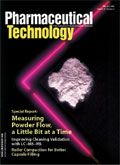News
Article
Pharmaceutical Technology
SOCMA Launches ChemStewards Program
Author(s):
This is a year of change for the Synthetic Organic Chemical Manufacturers Association (SOCMA), the Washington, DC-based trade association representing chemical batch and custom manufacturers. Following the sale of Informex, its flagship trade show, last fall, the association is advancing key programs, most notably its new ChemStewards program, an environmental, health, safety, and security initiative (EHS&S) that its members began implementing last month.
This is a year of change for the Synthetic Organic Chemical Manufacturers Association (SOCMA), the Washington, DC-based trade association representing chemical batch and custom manufacturers. Following the sale of Informex, its flagship trade show, last fall, the association is advancing key programs, most notably its new ChemStewards program, an environmental, health, safety, and security initiative (EHS&S) that its members began implementing last month.
The ChemStewards program, which features progressive tiers of compliance and third-party verification, replaces Responsible Care as the association's mandatory requirement for EHS&S. SOCMA announced last fall it would no longer require its members to achieve qualification under Responsible Care, the EHS&S program of the American Chemistry Council (ACC), the Washington, DC-based trade association primarily representing large US-based chemical manufacturers.
SOCMA had licensed the Responsible Care program for 15 years, but decided not to renew its license with the ACC when it expired last fall. The key rationale for this decision was to develop an EHS&S program that was better suited to the batch and custom manufacturers, distributors, and smaller chemical companies that constitute SOCMA's membership.
"Our decision not to renew our license with the ACC for the Responsible Care program and to instead develop the new program requirements under the ChemStewards program followed an 18-month review," says Joseph Acker, president of SOCMA. "We wanted a program that was more responsive to the needs of our members—the batch and custom manufacturer. By using a tiered approach and retaining the underlying principles of the Responsible Care program, we feel that we have achieved that."
Addressing small companies' needs was key in formulating the ChemStewards program. In surveying its membership, SOCMA found that 40 percent of small companies, defined as companies with revenues of $25 million or less, do not have a dedicated EHS manager. For the 60 percent of small companies with an EHS manager, the EHS-manager-turnover rate is roughly 25%.
"The Responsible Care program, which was developed for large chemical manufacturers, is really a one-size-fits-all approach," says Acker. "The core elements of the ChemStewards program include guiding principles, metrics, management systems, verification, and security, which are consistent with what members have been working on through the Responsible Care program. The only change is the development of a more flexible, balanced, and tiered approach to program implementation," he says.

SOCMAôs ChemStewards implementation schedule
The ChemStewards program offers three tiers of participation: Tier 1, fundamentals; Tier 2, enhanced performance; and Tier 3, excellence. All tiers require adherence to a set of core principles, in addition to security, metrics, and a verifiable management system. Qualification under the ChemStewards program is a requirement for membership in SOCMA, and implementation began last month. SOCMA member companies, however, that also are members of the ACC may elect to continue to participate under the Responsible Care program to meet their EHS&S requirement instead of participating under the new ChemStewards program.
The core principles of the ChemStewards program are common to all three tiers of participation and focus on performance improvement.These core principles are stakeholder communications, product stewardship, EHS considerations in operating and planning, employee training and awareness, and sustainability.
The ChemStewards program requires participants to report, on a yearly basis, a series of EHS&S metrics that vary based on the level of participation. All tiers of participation are required to report three metrics: (1) pounds of Toxic Release Inventory for air, land, and water releases (each reported separately); (2) Occupational Safety and Health Administration recordable incident rates for employees; and (3) the number of process-safety incidents. SOCMA's metric team is currently developing three additional metrics for Tier 2 participation. Tier 3 requires that a company meet certain metric parameters that also are also currently being developed, notes Acker.
The EHS&S management system requirements under the ChemStewards program are based on a continuous improvement cycle that builds upon a "plan, do, check, and act," approach, explains Acker. The focus of the Tier 1 management system is to determine which laws, regulations, and company requirements apply; to develop and implement a plan to address these areas; and to develop and implement a management system for maintaining compliance. These fundamental and regulatory-based components include items such as risk assessments, including security; legal requirements; training; accident investigations; regulatory-based goals and objectives; internal verifications; and requirements for addressing nonconformance.
The implementation elements under Tier 2 focus on enhanced performance and, in addition to basic legal and regulatory elements found under Tier 1, specify additional criteria for documentation, audits, review, and recordkeeping. For Tier 3 participation, companies must have a third-party verified management system in place such as ISO 14001, the Occupational Health and Safety Assessment Series (OHSAS) 18001 or the Eco-Management and Audit Scheme, the European Union's voluntary management tool for improving environmental performance.
ChemStewards uses a three-step verification process of a company's EHS&S management system, which includes both self-evaluation and a third-party review. "In developing this approach, we used a model based on the National Association of Chemical Distributors' Responsible Distribution program," says Acker.
Companies that are eligible for participation in Tier 3 must have a third-party verified management system in place and submit a copy of their verification documentation to SOCMA by Dec. 31 of each year. Tier 1 and Tier 2 participants are required to complete a program element verification (PEV) of their respective management systems by the end of this year. The PEV is a Web-based self-evaluation of a company's implementation of its management system that consists of a series of "yes" or "no" questions that help the company and SOCMA assess implementation status. Companies joining SOCMA after January 2006 are required to complete a PEV by Dec. 31 of the following year.
Tier 1 and Tier 2 participants also must undergo a desktop review and onsite verification of their respective management systems by a third-party verifier. The desktop review, which is required by each SOCMA member company by the end of 2007, includes verification of documented policies and procedures. Third-party onsite verification of a company's management system is required for each SOCMA member company by the end of 2008. The certification cycle will renew in January 2009, and third-party verification will thereafter occur on a three-year time frame. The verification process is based on a protocol rooted in the core elements of the respective Tier 1 and Tier 2 management system requirements. For Tier 2 participants, companies that already have a third-party verified EHS&S management system in place, such as a combined ISO 14001 and OHSAS 18001 system, can receive credit if they submit a copy of their verification documentation to SOCMA by the end of each year.
SOCMA is in the process of selecting the designated third-party verifier for both the desktop review and on-site verification process. "We hope to have this finalized over the next several months," says Acker.
SOCMA will continue to conduct regional networking meetings to train member companies in the ChemStewards program. In all, SOCMA will hold 24 meetings throughout 2006, which will entail three major meetings in eight different regions across the United States. SOCMA will continue to hold monthly teleconferences for its members on specific aspects of the ChemStewards program. SOCMA also has developed and made available to its members an EHS&S management system guidance that is split into eight functional modules to assist members in the implementation process. The modules are intended to allow the membership to implement the system in "bite-size" pieces by only implementing portions at a time.
Plant security is another key component of the ChemStewards program. Many of the security management systems for SOCMA members will be integrated with member companies' existing EHS assessments. The ChemStewards program does not specifically delineate security practices from the EHS&S management system, with the exception of the security vulnerability assessments (SVA), countermeasures, and third-party verification of countermeasures.
All companies participating in the ChemStewards program must conduct the SVA and implement appropriate site security enhancements. Also, facilities covered by the Environmental Protection Agency's (EPA) Risk Management Program (RMP) must conduct third-party verification of physical enhancements. RMP facilities are identified by the EPA as having greater potential for off-site consequences because of accidental releases. For new SOCMA members, companies must complete an SVA within six months for RMP facilities and within 12 months for non-RMP facilities. Implementation of security enhancements is required within two years after joining SOCMA. Third-party verification of RMP facilities is required 27 months after joining SOCMA. Existing members completed all security requirements by June 2005.
Just as the time for a process hazards analysis varies, the time required for an SVA will also vary from facility to facility, depending on the methodology chosen, the complexity of the plant, the hazards present, the time required to compile the plant security information, the level of previous security analysis, the skill of the team leaders, and the expertise and size of the team.
SOCMA is providing its members several guidance tools for an SVA, including the SOCMA Manual on Chemical Site Security Vulnerability Analysis Methodology and Model and the related analysis model software, which tailors SVA methodology and analysis to a batch manufacturing environment. Other sources that address security vulnerability assessments are published by the Sandia National Laboratories and the Center for Chemical Process Safety.
Synthetic Organic Chemical Manufacturers Association (SOCMA)

Joseph Acker, President of the Synthetic Organic Chemical Manufacturers Association
Headquarters: Washington, DC
Founded: 1921
Member companies: 274
President: Joseph Acker
Board of Governors*
Chair: Margaret Walker, vice-president, engineering solutions, technology centers, and manufacturing and engineering work process, The Dow Chemical Company
- Vice Chair: Charles Hinnant, president and CEO, Charkit Chemical Corporation and chairman, Optima Chemicals LLC
- Vice Chair: Larry Brotherton, CEO, Ortec Inc.
- Treasurer: John Nicols, vice-president, fine chemicals, Albemarle Corporation
- Secretary: Nick Shackley, vice-president, sales and business development, Cambrex Pharma and Biopharmaceuticals
*until September 2006
Source: SOCMA
Pharmaceutical Technology at Informex
Newsletter
Get the essential updates shaping the future of pharma manufacturing and compliance—subscribe today to Pharmaceutical Technology and never miss a breakthrough.





